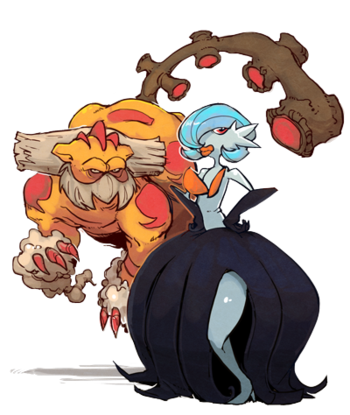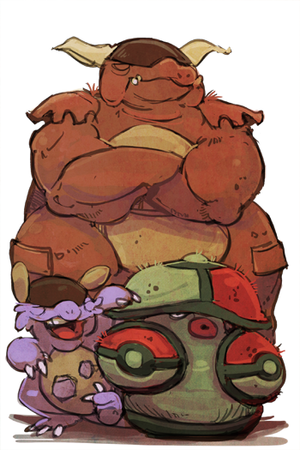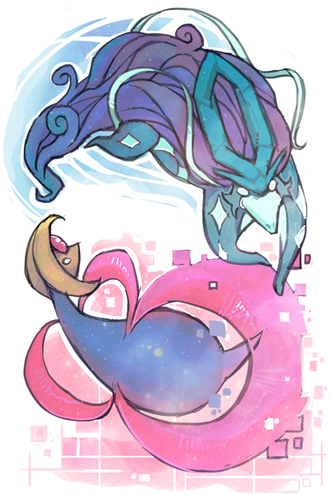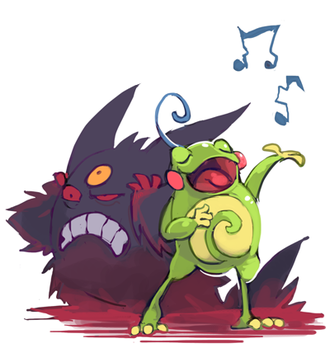Archetypes in the VGC '15 metagame: Part 1
| « Previous Article | Home | Next Article » |
Introduction
Hey! Sebastián Lara here, also known as Steven Stone on the forums.
When I started playing VGC, I didn't have any idea of what to run until one of my friends helped me get to know the most common Pokemon in the metagame back in 2012. The same thing has started happening to me when I've helped people teambuild for VGC 2015, but the issue is that you can't build a team just by knowing the common Pokémon in the metagame. If you try to build a team around them you'll often find yourself in the situation that each Pokémon can handle the threats they're meant to handle really well, but there's no synergy between the partners at all. So, to help all of you make the best team that you can, yours truly and a group of VGC players will describe each of the popular VGC team archetypes, mentioning every single detail that we can identify. Well, without further ado, let's get started!
Section 1: General Playstyles
This section will be dedicated to tactics such as manual speed control, gimmicky archetypes that are skill based enough to make it here (no Minimize archetypes, sorry), and, most importantly, regular teams that aren't based on weather or are based on other speed control that isn't Tailwind.
1) General Buildings

Common Pokémon:
Honorable Mentions:
Common answers
The answers for this archetype will depend on the opposing Mega Evolution. Also, while teambuilding, some players leave holes open for Pokémon that aren't as common, such as Volcarona and Scizor.
Description
The Pokémon in this archetype are known for their success in tournaments, as well as being the most powerful, bulky, and versatile Pokémon in the metagame. The building process is simpler than it looks: one picks a Mega Evolution and tries to cover as much of the metagame as possible by picking teammates that have good synergy and can fulfill multiple roles, such as providing speed control and tanking attacks.
Example:
I know, I know; you probably have seen a similar team structure while playing online. This is Riley Factura's Seattle Regionals team, which i found to be perfect for describing this archetype. Kangaskhan as the team's Mega Evolution says enough for itself (i mean, Kangaskhan won Worlds and was on both sides of the field), while the very common double genies core of Landorus-T and Thundurus makes for yet another appeal on these teams. Heatran was most likely added to patch up the Ice weakness the team had at that point, and Sylveon has one of the strongest spread attacks in the entire game. Amoonguss is a supportive Pokemon meant to pair with Power-Up Punch Mega Kangaskhan, while also taking hits from bulky Water-Types and being able to hit Fairies for super effective damage with Sludge Bomb.
Common Mindset (sung to Royals by Lorde):
"But every game's like, turn one Fake Out, Tailwind on Suicune
Rock Slide, Choice Scarf, prayin' it'll flinch soon,
We don't care; we're running Camerupt and ice creams.
But everybody's like, Prankster, Thunder Wave, spam it for the paralysis
Brave Bird, Heatran, tigers on their cloud feet.
We don't care; like my Bibarel we're Unaware."
"And well never be boring (boooooring)
We're having fun just like we should,
Mega Kangaskhan just ain't for us.
We're more into stuff like Mandibuzz.
Let's just say that I'm cooler (cooooler),
I'd even use a male Combee
And baby I'm cool, I'm cool, I'm cool, I'm cool.
Let me live that fantasy."
-Zog
Yep. I'm sure that this little song describes it rather accurately. Well, this archetype can give you some surprises, like a random Trick Room Gengar as your Suicune sets up Tailwind, or an Ice Punch Kangaskhan destroying that Landorus you thought you could switch in safely, but to be fair, if you ever play online, the players will most likely be using really generic sets. Identifying their strategy on Team Preview is important, but don't let your guard down: some players are smart enough to bluff this archetype and give you some surprises.
Pros:
- The team uses Pokémon that are really solid enough to pull their weight alone like Mega Kangaskhan, meaning that they don't need as much support as some other Pokemon. It also has a wide variety of Pokémon that can work alongside the Mega Evolution you choose, mixing up your gameplan and making yourself a bit unpredictable. Speaking of unpredictable, players are expecting the generic sets, so in best-of-one sets such Battle Spot, surprise sets can... surprise your opponent.
- The team often has a really strong luck factor on its side, such as Choice Scarf Rock Slide from Landorus-T together with Thunder Wave (and even Swagger) from Thundurus. Having Lady Luck on your side is quite useful.
Cons:
- Players are expecting this, and preparing for it as a result. Offensive archetypes can exert a lot of pressure on this archetype, and usually when teambuilding you always leave a hole that a specific Pokemon can break. Face against it, and you're doomed.
- Lady Luck's feelings are rather unstable. :P
Reports:
- Following a Mix of Naive Ideals (2015 season report by R Inanimate).
- Ruby Slippers (Top 4 Australia Nationals)
- Standard Six Squad with a Twist (Seattle Regionals 1st Place)
- Screaming through the Desert (2nd Place South California Regionals)
- A Thunder Storm Brews in Brisbane! (Undefeated Swiss Brisbane (AUS) Regionals)
- Shaping the Metagross (European Regionals Runner Up)
- Best in Show (4th Place St. Louis and 7th Place Orlando Regionals)
- Timequake! (1st Place Missouri Regionals)
- A Midsummer Knight's Team (13th place US Nationals)
- Cup Your Ears! Hyper Voice Incoming! (Top 32 Singapore Regionals)
- Be My Friend (Taiwan Regionals Champion)
2) Bulky Offense

Common Pokémon:
Honorable Mentions:
Common Answers:
and anything that can either break bulky offense or wall it. Life Orb attackers,setup sweepers, and Calm Mind Cresselia are options that you should keep in mind. Crippling the bulky Pokémon with Will-O-Wisp or the rare Toxic is also a good option.
Description
Bulky offense, as the name states, is the balance between damage output, speed, and bulk. This archetype typically consists of a Mega Evolution whose stats are great both offensively and defensively, a bulky Tailwind setter, two to three Pokémon that are great both offensively and defensively, and one hard hitter.
Trick Room bulky offense also exists, but given that you only need to move EVs to transform a team from regular Trick Room to Trick Room bulky offense, it's not really a different way of playing Trick Room. A Trick Room bulky offense player's mentality does not dramatically change from that of a player of regular Trick Room, so consider this playstyle to be a part of Trick Room.
Also, bulky offense teams are much slower than other teams. Their battles usually last around 8+ turns as well. Keep that in mind and prepare to fight a war rather than a battle.
Example:
This is Josh Krieger's Oregon Regionals team. Mega Venusaur was meant to take plenty of hits and beat Pokémon such as Milotic, Suicune, and Gastrodon, which Josh thought he didn't have an answer for otherwise. Zapdos is the Tailwind setter, handling Pokémon like Salamence, Mega Charizard Y, and most importantly, Talonflame. Blaziken was added to handle Mega Kangaskhan and Heatran, while Gyarados supported Blaziken by being able to handle Mega Salamence. Krookodile provided more Intimidate support without being 4x weak to Ice, which this team was really weak to already. Krookodile also helps this team break Cresselia and other Psychic-types. To finish this team, Scizor was added to help mitigate the team's Fairy weakness and to take on Trick Room teams, which this team otherwise struggled with.
General Mindset:
I try to lead often with Zapdos alongside a Pokémon that has the advantage in the most possible scenarios and try to set up my Tailwind up as soon as possible. Then, I start to play this team like hyper offense: I know my Pokemon will be able to withstand a hit and 2HKO whatever threat is active.
The most important thing about bulky offense is not losing momentum, as its main objective is to have the best matchup in all possible situations. You lose momentum by switching too much, but if you play it right, your opponent will switch out a lot too.
Also, with bulky offense, you don't need to bring your Mega Evolution all the time. You'll find yourself in situations that your Mega Evolution won't work better than your other 4 Pokemon. Heck, sometimes bulky offense is perfect for Double Mega teams too!
Pros:
- The is good type synergy between all the team members, as well as amazing coverage. This gives it the ability to take on all the metagame 1v1, because they're difficult to wear down.
- These teams generally have a good matchup against rain archetypes and other hyper offensive archetypes.
Cons:
- It's really difficult to keep momentum with bulky offense. This is because these teams lack speed, and rely on speed control most of the time.
- It's difficult to handle sand and Trick Room teams with them.
- The teambuilding process in general is complex, and the archetype loses to common Mega Evolutions like Kangaskhan and Salamence.
Reports:
- No Brakes from Here! (10th place Oregon Regionals) (Venusaur)
- I Woke Up Like This! (Top 16 Missouri Regionals) (Metagross)
- The Boss You Can't Take Down (Top 32 Singapore Nationals) (Venusaur)
- No One is Safe From the R.E.G.I.S MK-V (Alpha Series Top Cut) (Venusaur+Metagross Double Mega)
- L'Anse-aux-Méduses (2nd Place Missouri Regionals) (Metagross)
- Kings and Kahns (Top 4 Kansas Regionals) (Kangaskhan)
- Latios Takes Flight (Top 8 UK Regionals and Top 64 UK Nationals) (Kangaskhan)
- From Wannabe to Professional (Asia Pacific Circuit Top 2) (Kangaskhan)
- 20XX Mence (Two Time Regional Champion and Top 32 US Nationals (Salamence+Charizard Y Double Mega)
3) Semi-Room

Common Pokémon:
Honorable Mentions:
Common answers:
and anything that can stop the speed control method from going up. Taunt or Fake Out users are really good at this.
Description
Semi-Room is an archetype that has one primary and another secondary speed control method. Although Thunder Wave seems like a good option for primary speed control, Tailwind has been highlighted on the spot, creating the most popular variant of this archetype: TailRoom. As the name states, this is the combination of the Trick Room and Tailwind speed control options on the same team. This allows the team to choose the right speed control option for each specific opponent. For example, you can set up Trick Room while the opponent is operating under Tailwind or weather. Conversely, if the opponent doesn't have a clear speed control option you can set up Tailwind and start sweeping.
Semi-Room usually has one Trick Room setter and one or two primary speed control setters, and then you choose your remaining Pokémon to work in one or both modes.
Example:
This was Juichi Sasaki's TailRoom team that he used at the Japanese Nationals. Mega Gardevoir, his Trick Room setter, has an amazing typing that makes it synergize well with Amoonguss. In return, Amoonguss used its Rage Powder to keep attacks away from Mega Gardevoir, protecting it while it sets up Trick Room. Under Trick Room, Amoonguss becomes a menace, gaining access to the fastest Spore in the game. Suicune, on the other hand, worked as the team's Tailwind setter, boosting the Speed of Landorus-T, Thundurus, Heatran, and Gardevoir, all of which work amazingly under Tailwind. Landorus-T provided Intimidate support, while Thundurus completed the double genie core that's so popular in VGC. Heatran handled bulky Steel-types that Mega Gardevoir can't beat, particularly Aegislash and Mega Mawile, and created a pretty neat Fire / Water / Grass core with Amoonguss and Suicune.
General Mindset:
Uhh, can I call anything general here? Semi-Room is so full of surprises that I can't really do that. I can tell you the playstyle of TailRoom players will change depending on Team Preview: if the opponent has a Tailwind user, you should usually lead with the Trick Room user and a supporter to set up Trick Room as they set up Tailwind. Against opposing Trick Room, you should also lead with your Trick Room user and a supporter, but you work on it in a different way. This special way will depend on your Trick Room matchup and your opponent's team. Against weather teams, you lead depending on what weather you're facing. Against teams that don't have a clear speed control option, lead Tailwind+Support.
Pros:
- TailRoom is usually unpredictable, making it hard to play around. This is because TailRoom is the ultimate speed control option, allowing the team to have the speed advantage most of the time.
- TailRoom is fairly bulky and can handle a lot of threats. It also can punish Protect users with setup moves such as Substitute, Swords Dance, and Calm Mind.
Cons:
- TailRoom has a hard time dealing with regular Trick Room, as their the Pokémon commonly found on TailRoom are usually too fast for heavy Trick Room.
- TailRoom Pokémon have awkward bulk and get KOed far more easily than they should.
- It requires a lot of time to perfect and play effectively with it. This is because most TailRoom Pokémon struggle to function without the Speed advantage.
Reports:
- We Stand on Garde for Thee (2nd Place US Nationals)
- Scar's Mega Gardevoir with Goodstuff (6th Place World Championships)
- Boston, The Dream (Top 8 Senior World Championships)
4) Perish Trap

Let's all thank P3DS for this write-up!
Common Pokémon:
Honorable Mentions:
Common Answers:
and keeping up a lot of offensive pressure. Feint users can also mess with it badly.
Description
Perish Trap is one of the strongest archetypes around; however, it is the most difficult to master and one of the hardest to make consistent enough to function in high-level play. Don't let that put you off, however; a well-built Perish Trap team can be extremely deadly. This archetype plays very differently to your standard battle, as you rarely attack while you try to stall out the Perish Song turns. Because of this, a lot of players disregard Perish Trap as unsportsmanlike. However, Perish Song ignores Substitute, evasiveness, accuracy, and semi-invulnerability from moves such as Fly, bulk, Magic Coat, and Magic Bounce. It also reveals the Speed order of your opponent's Pokémon, giving you crucial information about the opponent's team. Although Perish Trap is good, you need to go all-out with your support for the team. Encore, Disable, Substitute, Swagger, Thunder Wave, Dark Void, Will-O-Wisp, Snarl, Intimidate, Rage Powder, Follow Me, and Fake Out all help our trappers survive, and so the trap survives as well.
Example:
This is Wolfe Glicke's Perish Trap team that he used to take first place at the Massachusetts Regionals. It relied on bulk to hold out for the duration of Perish Song. However, the team could flip the tables with a strong Trick Room core of Scrafty, Gothitelle, Amoonguss, and Politoed, so it could spread Spore and then use Perish Song before getting hit by other moves. The slow Pokémon all had 0 Speed IVs and Speed-reducing natures, so if it came to a two-on-two situation with Perish Song, his Pokémon would usually be the slowest, so he could just stall out the Perish Song turns.
Common Mindset:
Perish Trap demands a very smart player who can turn the course of the battle in their favor. You must have a strong will, as a lot of players regard this archetype as unfair and skill-less, and if you're playing online, they won't stop from letting you know. You must also be prepared to do what others would never do in regards to techniques on the team, utilizing moves such as Swagger, Encore + Disable, and Dark Void. You should have an eye for detail, picking up on as much information as possible, such as turn orders from Perish Song and noticing that the Poké Balls used can affect the abilities of certain Pokémon (for example, a Pokémon in an Apricorn Ball or Safari Ball cannot have its hidden ability by any means). Play intelligently with Perish Trap, and you will be rewarded for the effort.
Pros:
- Matches can be very fast paced. Due to the speed of the matches, you can conceal a lot of moves on your team, making it useful in a best-of-three match.
- Perish Song ignores all status moves and bypasses Substitute.
- Once Perish Song is up and the opponent can't switch their Pokémon, there is nothing that can stop it.
Weaknesses:
- Ghost-types, especially Aegislash, cannot be trapped and can deal super effective damage to your trapper.
- Dark-types, such as Bisharp and Hydreigon, are very annoying to deal with.
- Forced switches are hard to deal with. Items such as Red Card, as well as phazing, can force out your trapper, and Roar bypasses even Protect.
- Pokémon with pivoting moves, such as Landorus-T with U-turn, can escape from the trapper.
- Trick Room can mess up the turn order on Perish Song.
- Hyper offense can shut down your team pretty hard.
- Most of all, Perish Trap is very weak to hax. Critical hits, long sleep duration, freeze, confusion, and paralysis give the opponent free turns that you can't afford.
- Taunt stops Perish Song, so be wary around Thundurus.
- As stated before, Perish Trap requires a lot of mental strength and a very pre-calculated playstyle to make it work in high-level play.
Reports (Not many reports have been released in regards to Perish Trap):
- Wolfe Glicke's Perish Team (Interviewed by TheJustinFlynn)
- YT's 2014 Perish trap Rain team (A very strong team, that still lives up to this day)
Well, for what we've seen from these archetypes, they have placed relatively well in competitions thanks to some amazing players such as Wolfe Glicke, Aaron Traylor, Aaron Zheng, Baz Anderson, Zach Droegkamp, etc. Keep in mind that there's no better archetype: the playstyle, skill, and luck of each player will determine the victory!
Watch out for the second part of this installment, which will describe weather archetypes and some more of the most successful archetypes in the VGC history.
Take care, and have fun!
| « Previous Article | Home | Next Article » |